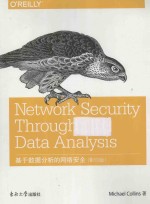

基于数据分析的网络安全PDF电子书下载
- 电子书积分:12 积分如何计算积分?
- 作 者:(美)柯林(MichaelCollins)著
- 出 版 社:南京:东南大学出版社
- 出版年份:2014
- ISBN:9787564150075
- 页数:327 页
Part Ⅰ.Data 3
1.Sensors and Detectors:An Introduction 3
Vantages:How Sensor Placement Affects Data Collection 4
Domains:Determining Data That Can Be Collected 7
Actions:What a Sensor Does with Data 10
Conclusion 13
2.Network Sensors 15
Network Layering and Its Impact on Instrumentation 16
Network Layers and Vantage 18
Network Layers and Addressing 23
Packet Data 24
Packet and Frame Formats 24
Rolling Buffers 25
Limiting the Data Captured from Each Packet 25
Filtering Specific Types of Packets 25
What If It's Not Ethernet? 29
NetFlow 30
NetFlow v5 Formats and Fields 30
NetFlow Generation and Collection 32
Further Reading 33
3.Host and Service Sensors:Logging Traffic at the Source 35
Accessing and Manipulating Logfiles 36
The Contents of Logfiles 38
The Characteristics of a Good Log Message 38
Existing Logfiles and How to Manipulate Them 41
Representative Logfile Formats 43
HTTP:CLF and ELF 43
SMTP 47
Microsoft Exchange:Message Tracking Logs 49
Logfile Transport:Transfers,Syslog,and Message Queues 50
Transfer and Logfile Rotation 51
Syslog 51
Further Reading 53
4.Data Storage for Analysis:Relational Databases,Big Data,and Other Options 55
Log Data and the CRUD Paradigm 56
Creating a Well-Organized Flat File System:Lessons from SiLK 57
A Brief Introduction to NoSQL Systems 59
What Storage Approach to Use 62
Storage Hierarchy,Query Times,and Aging 64
Part Ⅱ.Tools 69
5.The SiLK Suite 69
What Is SiLK and How Does It Work? 69
Acquiring and Installing SiLK 70
The Datafiles 70
Choosing and Formatting Output Field Manipulation:rwcut 71
Basic Field Manipulation:rwfilter 76
Ports and Protocols 77
Size 78
IP Addresses 78
Time 80
TCP Options 80
Helper Options 82
Miscellaneous Filtering Options and Some Hacks 82
rwfileinfo and Provenance 83
Combining Information Flows:rwcount 86
rwset and IP Sets 88
rwuniq 91
rwbag 93
Advanced SiLK Facilities 93
pmaps 93
Collecting SiLK Data 95
YAF 96
rwptoflow 98
rwtuc 98
Further Reading 100
6.An Introduction to R for Security Analysts 101
Installation and Setup 102
Basics of the Language 102
The R Prompt 102
R Variables 104
Writing Functions 109
Conditionals and Iteration 111
Using the R Workspace 113
Data Frames 114
Visualization 117
Visualization Commands 117
Parameters to Visualization 118
Annotating a Visualization 120
Exporting Visualization 121
Analysis: Statistical Hypothesis Testing 121
Hypothesis Testing 122
Testing Data 124
Further Reading 127
7.Classification and Event Tools:IDS,AV,and SEM 129
How an IDS Works 130
Basic Vocabulary 130
Classifier Failure Rates:Understanding the Base-Rate Fallacy 134
Applying Classification 136
Improving IDS Performance 138
Enhancing IDS Detection 138
Enhancing IDS Response 143
Prefetching Data 144
Further Reading 145
8.Reference and Lookup:Tools for Figuring Out Who Someone Is 147
MAC and Hardware Addresses 147
IP Addressing 150
IPv4 Addresses,Their Structure,and Significant Addresses 150
IPv6 Addresses,Their Structure and Significant Addresses 152
Checking Connectivity:Using ping to Connect to an Address 153
Tracerouting 155
IP Intelligence:Geolocation and Demographics 157
DNS 158
DNS Name Structure 158
Forward DNS Querying Using dig 159
The DNS Reverse Lookup 167
Using whois to Find Ownership 168
Additional Reference Tools 171
DNSBLs 171
9.More Tools 175
Visualization 175
Graphviz 175
Communications and Probing 178
netcat 179
nmap 180
Scapy 181
Packet Inspection and Reference 184
Wireshark 184
GeoIP 185
The NVD,Malware Sites,and the C*Es 186
Search Engines,Mailing Lists,and People 187
Further Reading 188
Part Ⅲ.Analytics 191
10.Exploratory Data Analysis and Visualization 191
The Goal of EDA:Applying Analysis 193
EDA Workflow 194
Variables and Visualization 196
Univariate Visualization:Histograms,QQ Plots,Boxplots,and Rank Plots 197
Histograms 198
Bar Plots(Not Pie Charts) 200
The Quantile-Quantille(QQ)Plot 201
The Five-Number Summary and the Boxplot 203
Generating a Boxplot 204
Bivariate Description 207
Scatterplots 207
Contingency Tables 210
Multivariate Visualization 211
Operationalizing Security Visualization 213
Further Reading 220
11.On Fumbling 221
Attack Models 221
Fumbling:Misconfiguration,Automation,and Scanning 224
Lookup Failures 224
Automation 225
Scanning 225
Identifying Fumbling 226
TCP Fumbling:The State Machine 226
ICMP Messages and Fumbling 229
Identifying UDP Fumbling 231
Fumbling at the Service Level 231
HTTP Fumbling 231
SMTP Fumbling 233
Analyzing Fumbling 233
Building Fumbling Alarms 234
Forensic Analysis of Fumbling 235
Engineering a Network to Take Advantage of Fumbling 236
Further Reading 236
12.Volume and Time Analysis 237
The Workday and Its Impact on Network Traffic Volume 237
Beaconing 240
File Transfers/Raiding 243
Locality 246
DDoS,Flash Crowds,and Resource Exhaustion 249
DDoS and Routing Infrastructure 250
Applying Volume and Locality Analysis 256
Data Selection 256
Using Volume as an Alarm 258
Using Beaconing as an Alarm 259
Using Locality as an Alarm 259
Engineering Solutions 260
Further Reading 260
13.Graph Analysis 261
Graph Attributes:What Is a Graph? 261
Labeling,Weight,and Paths 265
Components and Connectivity 270
Clustering Coefficient 271
Analyzing Graphs 273
Using Component Analysis as an Alarm 273
Using Centrality Analysis for Forensics 275
Using Breadth-First Searches Forensically 275
Using Centrality Analysis for Engineering 277
Further Reading 277
14.Application Identification 279
Mechanisms for Application Identification 279
Port Number 280
Application Identification by Banner Grabbing 283
Application Identification by Behavior 286
Application Identification by Subsidiary Site 290
Application Banners:Identifying and Classifying 291
Non-Web Banners 291
Web Client Banners:The User-Agent String 292
Further Reading 294
15.Network Mapping 295
Creating an Initial Network Inventory and Map 295
Creating an Inventory:Data,Coverage,and Files 296
Phase Ⅰ:The First Three Questions 297
Phase Ⅱ:Examining the IP Space 300
Phase Ⅲ:Identifying Blind and Confusing Traffic 305
Phase Ⅳ:Identifying Clients and Servers 309
Identifying Sensing and Blocking Infrastructure 311
Updating the Inventory:Toward Continuous Audit 311
Further Reading 312
Index 313
- 《水面舰艇编队作战运筹分析》谭安胜著 2009
- 《SQL与关系数据库理论》(美)戴特(C.J.Date) 2019
- 《计算机网络与通信基础》谢雨飞,田启川编著 2019
- 《中国铁路人 第三届现实主义网络文学征文大赛一等奖》恒传录著 2019
- 《情报学 服务国家安全与发展的现代情报理论》赵冰峰著 2018
- 《分析化学》陈怀侠主编 2019
- 《信息系统安全技术管理策略 信息安全经济学视角》赵柳榕著 2020
- 《数据库技术与应用 Access 2010 微课版 第2版》刘卫国主编 2020
- 《影响葡萄和葡萄酒中酚类特征的因素分析》朱磊 2019
- 《危险化学品经营单位主要负责人和安全生产管理人员安全培训教材》李隆庭,徐一星主编 2012
